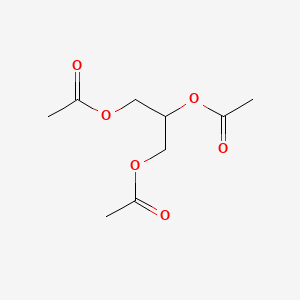| MeSH term | MeSH ID | Detail |
|---|---|---|
| Hemolysis | D006461 | 131 associated lipids |
| Body Weight | D001835 | 333 associated lipids |
| Glioma | D005910 | 112 associated lipids |
triacetin
triacetin is a lipid of Glycerolipids (GL) class. Triacetin is associated with abnormalities such as Vesicular Exanthema of Swine and Lobomycosis. The involved functions are known as National Institute for Occupational Safety and Health (U.S.), Softening, esterase activity, Process and Cell Growth. Triacetin often locates in Tissue fiber, Cell surface and Cytoplasmic matrix. The associated genes with triacetin are GRAP2 gene and Immobilized Proteins. The related lipids are Labrafil M 1944 CS, ethyl oleate and glyceryl monostearate.
Cross Reference
Introduction
To understand associated biological information of triacetin, we collected biological information of abnormalities, associated pathways, cellular/molecular locations, biological functions, related genes/proteins, lipids and common seen animal/experimental models with organized paragraphs from literatures.
What diseases are associated with triacetin?
triacetin is suspected in Vesicular Exanthema of Swine, Lobomycosis and other diseases in descending order of the highest number of associated sentences.
Related references are mostly published in these journals:
| Disease | Cross reference | Weighted score | Related literature |
|---|
Possible diseases from mapped MeSH terms on references
We collected disease MeSH terms mapped to the references associated with triacetin
PubChem Associated disorders and diseases
What pathways are associated with triacetin
There are no associated biomedical information in the current reference collection.
PubChem Biomolecular Interactions and Pathways
Link to PubChem Biomolecular Interactions and PathwaysWhat cellular locations are associated with triacetin?
Visualization in cellular structure
Associated locations are in red color. Not associated locations are in black.
Related references are published most in these journals:
| Location | Cross reference | Weighted score | Related literatures |
|---|
What functions are associated with triacetin?
Related references are published most in these journals:
| Function | Cross reference | Weighted score | Related literatures |
|---|
What lipids are associated with triacetin?
Related references are published most in these journals:
| Lipid concept | Cross reference | Weighted score | Related literatures |
|---|
What genes are associated with triacetin?
Related references are published most in these journals:
| Gene | Cross reference | Weighted score | Related literatures |
|---|
What common seen animal models are associated with triacetin?
There are no associated biomedical information in the current reference collection.
NCBI Entrez Crosslinks
All references with triacetin
Download all related citations| Authors | Title | Published | Journal | PubMed Link |
|---|---|---|---|---|
| pmid: | ||||
| Tatavarti AS et al. | A thermogravimetric analysis of non-polymeric pharmaceutical plasticizers: kinetic analysis, method validation, and thermal stability evaluation. | 2002 | AAPS PharmSci | pmid:12646015 |
| Cilurzo F et al. | Design and characterization of an adhesive matrix based on a poly(ethyl acrylate, methyl methacrylate). | 2008 | AAPS PharmSciTech | pmid:18563579 |
| Shakeel F et al. | Nanoemulsions as vehicles for transdermal delivery of aceclofenac. | 2007 | AAPS PharmSciTech | pmid:18181525 |
| Ahmed TA et al. | Biodegradable injectable in situ implants and microparticles for sustained release of montelukast: in vitro release, pharmacokinetics, and stability. | 2014 | AAPS PharmSciTech | pmid:24648158 |
| Baboota S et al. | Design, development and evaluation of novel nanoemulsion formulations for transdermal potential of celecoxib. | 2007 | Acta Pharm | pmid:17878111 |
| Inal O et al. | In vitro and in vivo transdermal studies of atenolol using iontophoresis. | 2008 Jan-Feb | Acta Pol Pharm | pmid:18536170 |
| Kogan A and Garti N | Microemulsions as transdermal drug delivery vehicles. | 2006 | Adv Colloid Interface Sci | pmid:16843424 |
| Bunupuradah T et al. | Use of taste-masking product, FLAVORx, to assist Thai children to ingest generic antiretrovirals. | 2006 | AIDS Res Ther | pmid:17194311 |
| Pang TW | Precision and accuracy of asbestos fiber counting by phase contrast microscopy. | 2000 Jul-Aug | AIHAJ | pmid:10976683 |
